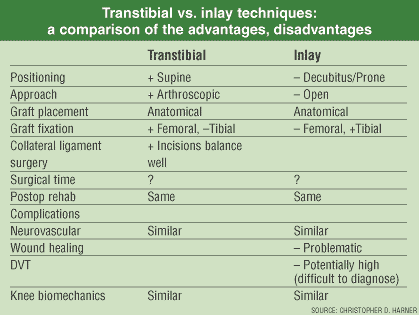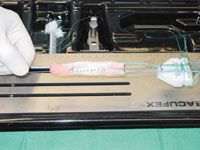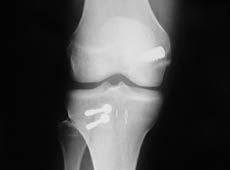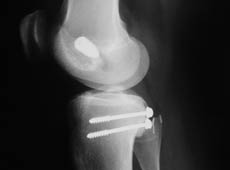Reconstructing the PCL: tips and techniques
Panelists consider the pros, cons of various techniques, including tibial inlay, transtibial tunnel, double bundle, single bundle and posterior tibial inlay
Posterior cruciate ligament reconstruction can be a challenging operation for the orthopedic surgeon. Currently, there appear to be four areas of major controversy: tibial fixation (posterior tibial inlay vs. tibial tunnel), graft bundle (double bundle vs. single bundle), femoral insertion (location/angle of fixation) and meniscofemoral ligaments (are they significant?). Orthopedics Today has assembled a panel of experienced proven experts on posterior cruciate ligament reconstruction to address these controversies and give their present method of reconstruction.
John A. Bergfeld, MD
Moderator
|
||||||||||||||||||
John A. Bergfeld, MD: Dr. Cooper, what is your rationale for the tibial inlay technique?
Daniel E. Cooper, MD: In evaluating my own results and those of other surgeons, I have been less than impressed with the long-term results of transtibial tunnel techniques for posterior cruciate ligament (PCL) reconstruction. Most of my experience with it was during the late ‘80s and early ‘90s. However, I have examined knees in my own clinical practice and at the National Football League combine over the past 15 years, and I remain unimpressed with the long-term durability of transtibial tunnel techniques for the reconstruction of the PCL. I simply have not been able to duplicate the results that some authors publish, and I began to search for a better technique.
Several studies have raised concerns regarding the acute angle at the posterior mouth of the transtibial tunnel and the effect this has on the graft. This effect falls under three categories: 1) high internal graft stresses due to the acute angular bend of the tunnel, 2) graft elongation as a result of cyclic loading, and 3) a higher incidence of graft failure with transtibial tunnel techniques as compared with tibial inlay fixation. These are well-documented in several studies of Bergfeld and Markoff.
In my quest for improving the technique for PCL reconstruction, I was led to the tibial inlay technique for several reasons: The technique was very useful in several revision cases 12 to 15 years ago in my practice. Also, I was encouraged by the success of the technique in difficult revision cases where a pre-existing transtibial tunnel existed, and I, therefore, began exploring the use of this technique for primary cases. My results with these cases led me to continue to use this technique.
I admit that whichever technique you pursue, you accept the difficulties of the technique and focus on the positives. In saying that, I think the difficulties of the tibial inlay technique relate primarily to the awkwardness of patient positioning. This improves as the surgeon becomes more experienced in the approach.

Bergfeld: Dr. Fanelli, what is your rationale for the transtibial tunnel technique?
Gregory C. Fanelli, MD: If I identify and treat all of the pathology (especially posterolateral instability), accurately place my tunnels using anatomic graft insertion sites, utilize strong graft material, minimize graft bending, perform my final PCL graft tensioning between 70° and 90° of knee flexion using the Arthrotek mechanical graft tensioner, use primary and back-up graft fixation — combined with the appropriate postoperative rehabilitation time — I can achieve a normal posterior drawer 91.7% of the time at two- to 10-year follow-up in chronic PCL-posterolateral reconstructions.
Bergfeld: Dr. Harner, explain your rationale for doing a double bundle PCL reconstruction.
|
COURTESY OF CHRISTOPHER HARNER |
Christopher D. Harner, MD: I have based my approach to PCL surgery on both anatomical as well as biomechanical principles. Basically I have evolved my technique over the years to address these fundamental areas. Currently I use a variety of techniques to address the various combinations of PCL injuries. It is important to remember that this is not an isolated procedure but is almost always done in conjunction with associated ligamentous, meniscal and articular cartilage injuries.
Anatomically the PCL can be broken down into three components: the anterolateral bundle, posteromedial bundle and meniscal femoral ligaments (AL, PM and MFL). These components have specific insertion sites and vary biomechanically. It is important to realize that the AL bundle is the largest and strongest component; thus, regardless of the technique utilized, one must at least reproduce its structure to restore PCL function.
To do this the surgeon must understand insertion site anatomy to achieve correct tunnel placement. If the location of the graft is correct then the specific technique to achieve this is not as important.
The double bundle technique is designed to more accurately reproduce the anatomy of the PCL and restore the AL and PM bundles (Figure 1). Research in our laboratory and others provide cadaveric biomechanical data to suggest it more closely restores normal knee biomechanics and stability in the PCL-deficient knee. By adding the second bundle (PM), this theoretically will improve knee biomechanics and patient outcomes.
Since beginning double bundle PCL surgery in 1999, I have been classifying cases into complete and partial injuries. I have found that in about one-third of chronic and acute cases, the PM and MFL components are intact. In this setting I perform a single bundle augmentation technique to preserve the PM bundle and MFL (Figures 2 & 3).
|
|
|
|
Bergfeld: Why do you use the tibial tunnel technique?
Harner: My rationale includes patient positioning, arthroscopic approach, anatomical graft placement, balanced incisions and equivalent knee biomechanics. See the table which summarizes a comparison of the advantages (+) and disadvantages (–) of the two techniques based on my experience with both techniques.
Bergfeld: Dr. Cooper, why do you use a single bundle reconstruction?
Cooper: The primary rationale for a single bundle reconstruction is that the anterolateral bundle of the PCL is the functional bundle that resists posterior translation at 90° of flexion. Other ligamentous structures that are either intact or reconstructed, such as the posterolateral corner, contribute to posterior stability at 30° of flexion. A single bundle technique should utilize a large and durable graft placed high within the intercondylar notch (when viewed arthroscopically). These are the most functional fibers of the PCL. Although a single bundle is a crude attempt at reconstruction of a complex multifibered ligament, a successful single bundle reconstruction can restore good posterior stability to the knee. A single bundle technique is generally easier to perform surgically and allows for a very large graft size. This is useful when combined with multiple other ligament reconstructions that take up surgical time.
Bergfeld: Dr. Harner, do you have any objections to the single bundle technique?
Harner: I have no significant objections as long as it reproduces the AL component and the associated injuries are addressed. In our experience, when single bundle is used while addressing associated injuries, we have had very good results, especially in an acute setting (< 3 weeks). However, we found a high incidence of failure with an isolated single bundle PCL reconstruction (Sekiya, AANA 22nd Annual Meeting 2003).
Finally, in the chronic setting even with addressing all associated injuries, single bundle PCL reconstruction was not as successful. Thus, I perform double bundle PCL reconstruction in two settings: chronic combined injuries and select revision surgery.
Bergfeld: Dr. Cooper, what is your opinion of the double bundle technique?
Cooper: I utilize the double bundle technique. I am currently comparing the double bundle technique to single bundle results in a prospective manner. We do not have any good scientific comparison proving a clinical advantage of the double bundle technique and confirming that it does not increase complication rates such as osteonecrosis of the medial femoral condyle or arthrofibrosis. Additionally, consideration should be given to the need to avoid “robbing Peter to pay Paul.”
It is very important to use a very large collagen graft to reconstruct the anterolateral bundle. A smaller graft can be used for the posteromedial bundle of the PCL. Care should be given to not greatly reduce the diameter of the graft used for anterolateral bundle reconstruction, but simply to insure that the posteromedial bundle is reconstructed.
I agree with the others that there are good data to suggest the kinematics are more closely restored to normal with a double bundle reconstruction than with a single bundle in the robot model from 0° to 120°. Whether that translates into more clinical success with the same or fewer complications has yet to be proven. Certainly, this is worthy of future study.
Bergfeld: You do, however, have objections to the transtibial tunnel technique? Why is that?
Cooper: My objections are as follows: (1) There are high internal graft stresses if an acute tunnel angle is formed at the mouth of the tunnel posteriorly.
(2) The technique is subject to intraoperative technical error, even in the hands of experienced surgeons. I have seen numerous malpositioned tunnels, both from the standpoint of anterior malposition and acute angular malposition. A very low trajectory and inferiorly placed “over the bottom” transtibial tunnel technique has an increased risk of vascular injury unless a generous accessory posteromedial incision is made.
(3) Transtibial tunnels tend to expand and migrate anteriorly over time, especially with an Achilles allograft.
(4) The length of the soft tissue grafts traversing a transtibial tunnel lead to decreased stiffness of the graft, as compared to shorter grafts with tibial inlay fixation.
(5) My experience with this technique was not as good as my experience with the tibial inlay technique. I have not been able to duplicate some of the excellent results published on this technique.
In general, highly successful techniques within orthopedics are borne out by being reproduced in multiple surgeons’ hands over the years with numerous publications of successful results.
Bergfeld: Dr. Fanelli, what do you think of the posterior tibial inlay technique?
Fanelli: I have no objections to the technique and have incorporated many of the tibial inlay technique surgical principles into my arthroscopic transtibial tunnel technique. In fact, I prefer to call my PCL reconstruction the arthroscopic transtibial inlay technique.
I feel strongly that as PCL surgeons we should be prepared to do any and all the PCL operations, especially in the context of revision PCL reconstruction surgery or where altered anatomy may preclude one technique or the other. For example, some patients with PCL injuries may have fractures of the knee that have been treated with internal fixation. This internal fixation may require the use of the tibial inlay technique instead of a transtibial tunnel technique.
Bergfeld: Do you have concerns about the posterior tibial inlay technique, Dr. Harner?
Harner: I have several concerns: (1) There are no differences biomechanically; (2) the posterior incision necessitates significant positional changes of the patient; (3) the posterior approach increases risk of neurovascular injury; (4) the posterior approach makes future surgery very difficult (i.e., revision, TKA); and (5) advocates of the inlay procedure claim that it avoids the “killer curve” on the tibia, but I would contend that the true “killer curve” (terrorist curve?) is on the femoral side.
Bergfeld: What is your current surgical technique for reconstruction of a chronic PCL tear?
|
COURTESY OF DANIEL COOPER |
Cooper: I use a double bundle PCL reconstruction technique using an allograft BTB graft and tibial inlay fixation. The tibial tubercle portion of the allograft is fashioned into a 12-mm to 13-mm wide block harvested from a whole BTB allograft. Two-thirds of the width of the patellar tendon is used for the anterolateral bundle and then an 8-mm strip for the posteromedial bundle. Bone plugs are taken from the patella for each of these grafts. The wider portion of the graft used for the anterolateral bundle is tubularized in order to provide more collagen than just the width of the plug.
Tibial inlay fixation is used with two 45 mm x 4.0 mm cancellous screws using small ASIF metal washers. Femoral tunnel placement is performed with an arthroscopically assisted technique and an outside-in drilling technique, trying to create a trajectory that points toward the tibial insertion and, therefore, decreases the angular deviation of the femoral tunnel from the graft.
The anterolateral bundle tunnel is an 11-mm tunnel reamed over a guide pin placed approximately 6 mm inside the articular reflection at 11:30 or 12:30. This yields a graft position at the 11:00 or 1:00 position, respectively. The tunnel for the posteromedial bundle is more posterior on the medial femoral condyle, but within the footprint of the fibers of the PCL attachment. This is an 8-mm tunnel for reconstruction of the posteromedial bundle.
Femoral tunnel drilling and all arthroscopic procedures are performed first. The knee is then placed in the figure 4 position and a posteromedial approach, as described by Burks, is performed. A rectangular inlay slot is made connecting directly to the tibial footprint of the PCL. The graft is keyed in and fixed with the two cancellus screws. Care is taken to impact the graft for compression, rather than trying to compress the graft by overtightening the screws.
Through a posterior capsulotomy, the posteromedial bundle is passed first. This is a smaller plug with a little bit tighter turn into a small tunnel, and I prefer to pass this bundle first. The anterolateral bundle is then passed through the larger diameter tunnel. Fixation is interference fixation.
This technique provides for a short, stiff graft with tibial inlay rigid fixation and interosseous interference screw fixation. The anterolateral bundle is tensioned at 90° with a physiologic 10-mm anterior step-off restored. The knee is then straightened to full extension, and the posteromedial bundle is tensioned and fixed with an interference screw.
It is important to carefully assess the necessary length of allograft required. The patient’s own patellar tendon length, up to 5 mm longer, is usually acceptable for reconstruction. Any graft shorter than the patient’s patellar tendon can cause difficulty with turning the plugs into the femoral tunnel. Any graft more than 5 mm longer than the patient’s own patellar tendon can cause difficulty with the graft being too long and prominent at the external mouth of the femoral tunnels. In general, X lengths of 45 to 50 are used for the average-sized patient. For patients over 6’3”, great care should be given to accurate preoperative planning.
|
COURTESY OF DANIEL COOPER |
Bergfeld: Dr. Fanelli, what is your current technique for reconstruction of a chronic PCL tear?
Fanelli: My technique is an arthroscopically assisted single bundle transtibial tunnel technique using an Achilles tendon allograft. It is critically important to realize that this type of injury is rarely an isolated PCL tear, and the most likely scenario is a combined chronic PCL-posterolateral instability. Failure to recognize and treat the posterolateral instability will result in PCL reconstruction failure.
When treating combined PCL-posterolateral instability cases, my current technique is an arthroscopically assisted single bundle transtibial tunnel PCL reconstruction using an Achilles tendon allograft combined with a posterolateral reconstruction that utilizes a semitendinosus allograft, posterolateral capsular shift, and when possible, primary repair.
Bergfeld: What can you tell us specifically about the femoral insertion and femoral reconstruction side of the PCL reconstruction?
Cooper: This is the cornerstone area of PCL reconstruction. Although transtibial tunnels may increase the internal stresses on the graft and long grafts decrease the stiffness of the graft, it is the femoral fixation that dictates the kinetics and graft excursion patterns. I think we may oversimplify things by talking about one bundle vs. two bundles, when in fact the fiber patterns are probably closer to 1000 bundles.
No matter how many bundles we try to reconstruct, we are never truly duplicating the kinematic behavior of this multifibered ligament. If we can more approximate the natural kinematic behavior of the PCL throughout range of knee motion, and do so without increasing the complication rate or greatly increasing the surgical time, then obviously we should make an effort to do so.
I would point out that there is no reliable technique for reconstructing the PCL that consistently restores normal posterior translation, normal knee kinematics and full range of motion. You almost always have to sacrifice in one area. It might be fine to sacrifice a few degrees of terminal hyperflexion and reconstruct with a very robust anterolateral bundle. Do we need to restore normal kinematics within a limited range and yet sacrifice motion to do so? These are unknowns.
Bergfeld: Dr. Fanelli?
Fanelli: The femoral insertion site of the PCL may be as large as 3 cm. The double bundle PCL reconstruction attempts to reproduce the broader femoral insertion site of the PCL. To optimize stability and surgical results using the single bundle PCL reconstruction, femoral tunnel placement is very important.
I position my femoral tunnel through the femoral insertion site of the PCL anterolateral bundle region. On the arthroscopic intercondylar notch view, the femoral tunnel extends from the 12:00 position to the 3:00 (right knee) or 9:00 (left knee) position. A large Achilles tendon allograft is used (11 mm to 13 mm), and the corresponding femoral tunnel occupies a large portion of the PCL femoral insertion site.
This femoral tunnel position and allograft size, combined with minimizing graft bending, tensioning the graft between 70° and 90° of knee flexion using the Arthrotek mechanical graft tensioner, and using primary and back-up graft fixation, provides very reasonable results.
Bergfeld: What is the role of the meniscofemoral ligaments?
Fanelli: They may play a role in stabilizing the lateral meniscus and may help the PCL control posterior tibial translation.
Cooper: The meniscofemoral ligaments are somewhat variable. The vast majority of patients have one or the other, but a smaller percentage has both. This is documented in numerous anatomical studies. We know that they can constitute up to a third of the cross sectional area of the PCL. We also know they can contribute to posterior translational stability, but only after transection of the PCL itself.
There is some debate about their role in rotational stability and whether or not internal rotation of the tibia increases posterior stability of the knee through increased tension in the meniscofemoral ligaments. The recent work of Bergfeld and McAlister would suggest this is more likely capsular structures, rather than the meniscofemoral ligaments. Therefore, from the standpoint of controlling posterior translation, they do not have much of a primary role.
Bergfeld: What do you do with any remaining meniscofemoral ligaments found at the time of your reconstruction?
Cooper: I try to preserve robust meniscofemoral ligaments at the time of reconstruction. It is not that difficult to sneak an anterolateral bundle between the meniscofemoral ligaments, or certainly preserving a large ligament of Humphrey. It is a little bit more difficult to preserve the ligament of Wrisberg with the debridement of the PCL fibers. I have had cases with a very large robust intact ligament of Humphrey that have led me to prefer a single bundle reconstruction.
It is impossible to leave a large ligament of Humphrey and still place an accurate tunnel for the posteromedial component of double bundle reconstruction. It is much easier to preserve the meniscofemoral ligaments with a single bundle reconstruction, and I use this if that is the goal. That is more likely to be the case in acutely injured knees, as compared to chronic severely lax knees or revision cases.
Bergfeld: Dr. Fanelli?
Fanelli: The meniscofemoral ligaments may help the PCL control posterior tibial translation in the intact uninjured knee. In a knee with a complete PCL tear with 10 mm to 15 mm of pathologic increased posterior tibial translation, the meniscofemoral ligaments are most likely either completely torn or attenuated to the point of dysfunction.
Three very critical aspects of successful PCL reconstruction are accurate tunnel placement, reproducible graft tensioning and secure fixation. I do not routinely preserve any remnants of the damaged meniscofemoral ligaments because I do not want this compromised tissue to adversely affect the accuracy of my tunnel placement or graft tensioning.
Bergfeld: Do you think they play any significant role in contributing to the stability of the PCL reconstruction?
Fanelli: It seems that for the meniscofemoral ligaments to support the PCL reconstruction, the resting length of the meniscofemoral ligaments must be short enough to support the PCL reconstruction when the tibia is reduced and the PCL graft tensioned.
In my clinical experience, the meniscofemoral ligaments do not play any significant role in contributing to the stability of the PCL reconstruction.
Cooper: The meniscofemoral ligaments probably play a secondary role, but we know from numerous bench studies that the PCL is the primary restraint to posterior translation at all degrees of flexion. Since all of my PCL reconstructions are all perfectly stable with 0 mm of posterior translation, I would not expect the meniscofemoral ligaments to play any significant role.

![John A. Bergfeld, MD [photo]](/~/media/images/news/print/orthopedics-today/2005/01_january/bergfeld_70_90_1952.jpg) John A. Bergfeld, MD
John A. Bergfeld, MD![Daniel E. Cooper, MD [photo]](/images/content/ot/200412/cooper.jpg) Daniel E. Cooper,
MD
Daniel E. Cooper,
MD![Gregory C. Fanelli, MD [photo]](/images/content/ot/200412/fanelli.jpg) Gregory C. Fanelli,
MD
Gregory C. Fanelli,
MD![Christopher D. Harner, MD [photo]](/images/content/ot/200412/harner.jpg) Christopher D. Harner,
MD
Christopher D. Harner,
MD![Figure 1 [drawing]](/~/media/images/news/print/orthopedics-today/2004/12_december/fig1pcldblbdl_200_218_1708.gif)
![Figure 2 [photo]](/~/media/images/news/print/orthopedics-today/2004/12_december/fig2pclaug_230_176_1708.jpg)
![Figure 3 [photo]](/~/media/images/news/print/orthopedics-today/2004/12_december/fig3pclaug_230_176_1708.jpg)


